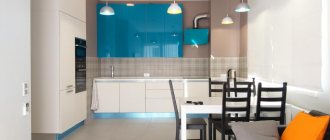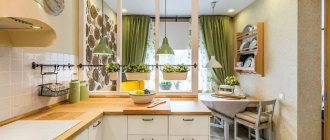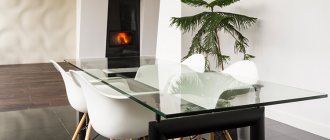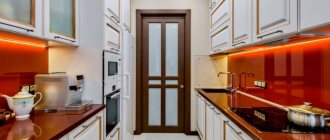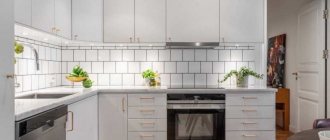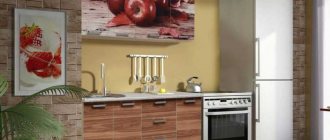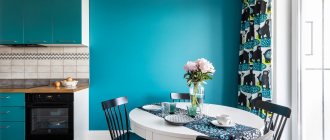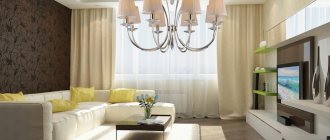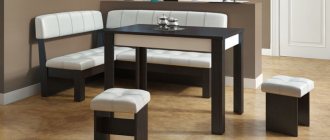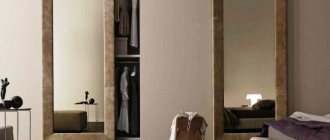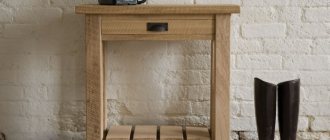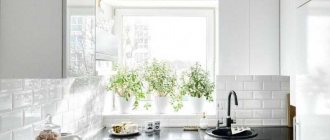Advantages and disadvantages of glass facades
Any finishing material has its pros and cons associated with the characteristics of its operation. The advantages of glass surfaces in the kitchen are the following factors:
- resistance to high humidity and temperature changes;
- strength (modern technologies make it possible to produce surfaces for facades that are insensitive to mechanical stress);
- hygiene (uniform texture prevents the formation of colonies of pathogenic bacteria);
- ease of care (there are a large number of available products for cleaning glass surfaces);
- texture compatibility with other finishing materials;
- the ability to use glass to decorate kitchens in various styles;
- beauty and grace.
The list of disadvantages of using glass surfaces in a food preparation room looks like this:
- characteristic noise when in contact with various utensils;
- high price;
- rapid contamination when touching surfaces with hands.
Glass facades: how they are used in kitchen units, pros and cons
The advantage of the material is environmental friendliness and hygiene . Glass does not absorb dirt and moisture, which prevents the formation of mold and mildew. During operation, the material does not release toxic or hazardous substances into the air.
One of the advantages is the wear resistance of glass . It tolerates sudden temperature changes, heat and steam, and high humidity. Over time, such facades do not deform or fade from the sun, and retain their original shine and attractive appearance.
Glass harmoniously combines with any materials , be it expensive natural solid wood or budget plastic. With the help of different design options, it is easy to match the glass facade to any interior style.
Attention! Glass façades require a regular glass cleaner and a soft cloth to clean, but they require frequent cleaning. If you do not take care of the appearance of the surface, stains and stains will appear on it over time.
The downside of glass facades is fragility and weak immunity to shock. If handled carelessly, the glass will break, injuring a person. They also note the cost: high-quality glass facades are expensive.
Types of glass
This material has many variations that differ in production technology and physical properties. For kitchens, you should choose the most durable types of glass, especially for the lower tiers of the set. Upper facades are less likely to be subjected to mechanical stress and therefore allow the use of more fragile and affordable options. However, if possible, it is better to completely decorate the set with reliable materials.
Acrylic
Such glass is rarely used to decorate kitchen facades. This is due to the low thermal stability of acrylic. Under the influence of high temperatures, such surfaces can become deformed. Therefore, it is mainly used to decorate the upper tiers of the kitchen. This material is flexible during the finishing process. It is quite easy to cut and convenient to apply all kinds of decorative patterns.
Laminated
This procedure allows you to obtain more durable facades. Applying a protective film increases the reliability and service life of glass inserts. They become less susceptible to mechanical stress. Thanks to lamination, glass facades acquire a beautiful matte texture. Through such translucent glass, vague outlines of objects will be visible - this fact is important for those who do not want to display food and kitchen utensils. In addition to increasing strength, lamination allows you to apply any patterns to surfaces using special decorative films.
Tempered
After a certain heat treatment, glass for facades acquires high viscosity. The natural result of this is the strength and durability of products made from hardened material. If such an insert breaks, the glass shatters into many small cubes with rounded edges. It is impossible to cut yourself on such fragments. Another positive quality of tempered glass is heat resistance. Therefore, it is often used to decorate surfaces located in close proximity to the hob.
This material has disadvantages. One of them is the impossibility of drilling and cutting after finishing the processing. All holes necessary for the facades must be made before hardening. In addition, such glass has a large mass. This fact should be taken into account when organizing the movement of kitchen units.
Triplex
Such glass consists of two thin components connected using a polymerizing composition. Triplex has increased strength. Such a multilayer structure is difficult to break even if desired. If this happens, the fragments of the facade do not scatter in all directions. In addition, they do not have sharp edges. This fact makes the use of triplex safe for apartments where there are small children.
Is there an advantage of glass facades over facades with glass inserts?
Glass facades combine attractive appearance and originality, practicality and environmental friendliness . There is no need to look for options where, in addition to glass, there is another material: wood, plastic, MDF or chipboard.
However, in each case everything is individual. In one kitchen only glass is appropriate, in another - plastic or wood with glass inserts . The only advantage of the second option is that such facades are cheaper than all-glass ones.
Types of glass structures
There are several variations of facades made of this material. They differ in the way they are attached directly to the headset. For each, the type of glass recommended for installation should be used. The need for a selective approach is due to compliance with safety regulations.
Frame
This finishing method requires the presence of glass inserts of different sizes in facades made of solid wood, MDF, and chipboard. Aluminum profiles are also used to fasten fragments. Depending on the style of the kitchen, you can use wide and narrow frames for inserts. Such designs make it possible to use less durable types of glass, since the main load falls on the base material of the headset.
Frameless
This type of construction is also called solid or slab. This option involves installing facades made entirely of glass. The edges of the surfaces must be polished and placed in a thin metal profile. Only the strongest types of glass - tempered and triplex - are suitable as materials for the manufacture of frameless facades. The large weight of such structures requires the use of reliable and high-quality fittings for fastening.
How to properly care for kitchen glass facades
For cleaning, use glass cleaners and soft sponges . Hard metal sponges and detergents containing abrasives are not suitable, otherwise scratches will appear on the surface. Water stains and grease stains quickly appear on such facades, so it is recommended to wash the kitchen at least once a week.
Ways to decorate glass facades for the kitchen
There are simple and complex methods for decorating kitchen surfaces made from this material. The first includes the use of transparent and colored glasses of various shapes. Matting of surfaces is also considered a simple way of decoration, which allows you to create interiors in various styles. Dull inserts may look appropriate in “rustic” kitchens. To create modern interiors, use illumination of frosted glass from inside the set.
Complex methods of decorating glass facades include:
- sandblasting;
- stained glass;
- engraving;
- tinting;
- glass painting;
- photo printing.
In classic interiors
At first glance, this material does not quite suit classic interiors - they expect something more familiar.
However, judging by the reviews, a tempered glass facade looks good in this design style - the main thing is to choose the right colors. You can make transparent embossed doors. They look stylish and modern without disturbing the overall stylistic harmony. We advise you not to save money: if the glass elements are not strong enough, they can burst even under the influence of steam.
At the same time, glass does not have to be mirror or transparent: modern technologies allow it to be painted in any color. We recommend light beige - the elegant set fits perfectly into the design and seems very stylish.
Translucent elements go well with wood. Choose appliances that are similar in shade to create a cohesive look.
An interesting move: You can install a protective glass panel on the apron. This will protect the wallpaper from dirt.
Options for kitchen spaces where it is appropriate to use glass on facades
This material provides many variations for decorating kitchens in different styles. The ability to choose between neutral or colored surfaces is an additional way to add variety to your room. Multiple methods of glass processing allow you to choose the best option for any headset.
In classic interiors
In such kitchens it is appropriate to use frame structures. Options with several inserts of different sizes are allowed. For classic kitchens, it is better to use transparent glass or light-colored elements. Inserts can be either glossy or matte. The first option is suitable for elegant formal rooms, the second - for more restrained, antique-style rooms.
In modern interiors
A variety of methods for processing glass surfaces allows this material to be successfully used for decorating fashionable styles. High-tech, modern, avant-garde, loft benefit from the use of such a design technique. In modern styles, matte, glossy and combined fragments are successfully used. Lighting plays a big role in creating the image of a kitchen. With its help you can fully reveal the beauty of glass facades.
In a small kitchen
Glass facades are an original and affordable way to decorate a small cooking room. With their help, it is possible to visually enlarge the room, making the kitchen set less bulky. For the same purpose, you should opt for light glossy surfaces. The façade fittings should be uncomplicated. In a small kitchen you should avoid complex designs and curved lines.
In the kitchen-living room
Such a room allows you to combine different types of glass inserts. Its dimensions provide the opportunity to choose darker tones of the facades. The interior of the kitchen-living room requires elements that divide it into different zones. To create a complete look, you can complement the set with a peninsula or a bar counter with a glass top.
In the kitchen-living room
There are more requirements for the design of such rooms: any inaccuracy in the kitchen design disrupts the harmonious perception of the entire area.
Try to choose a set and a kitchen island with facades of different textures: rich glossy glass, translucent matte, minimalist finish. This kind of interior is now at the peak of fashion. And for good reason - it’s both beautiful and practical.
Work with the shapes. Glass in bright colors is often used not only for facades, but also for decorating various structural elements. We liked this option: a muted shade of light green, an original bar counter with a panel bordering it. Unusual and modern.
However, a simple white surface will be no worse. If you like more traditional types of designs, consider this one. It looks stylish, and thanks to the properties of the materials, maintenance will not be difficult.
Plain facades in deep tones are another almost classic technique. It is better to choose rich colors - for example, dark burgundy. It wouldn’t look good in a small room, but here it seems appropriate. True, the decor needs to be selected carefully - such shades behave capriciously, and the abundance of details can ruin the effect.
As you can see, glass facades are not the usual transparent panel, like on a window, but a very diverse material that provides many design possibilities. It suits any design style and easily fits even into a non-standard interior.
Photos of kitchens with glass facades in the interior
Designer glass facades for the kitchen
When choosing glass facades for a kitchen, most customers evaluate the external characteristics of the structure. Indeed, we create unique products, offering customers a huge selection of design ideas. When making glass facades for kitchens, we use various types of glass; you can order combined options. Glass can be decorated using engraving methods: branding, inscriptions, patterns, and drawings are applied to kitchen structures.
All glass processing work (grinding, drilling, polishing) is carried out before the hardening process. A protective coating is applied to the glass, which ensures resistance to dents, chips, and scratches. No folds or bubbles form on the surface even when the temperature rises.
For each customer we develop a unique design layout. You can choose any color scheme; there are various types of glass to choose from: tinted, corrugated, frosted, etc. Any design can be complemented with ornaments, glass products can be frameless, and we also offer the production of spectacular and stylish frames from MDF, solid wood, and aluminum profiles. Details of the front kitchen can be painted and varnished. Thus, the designer and customer have a simply limitless number of variations of glass facades.
